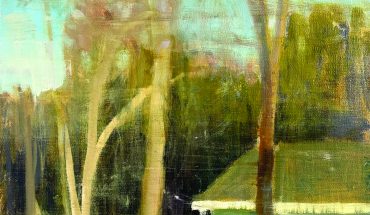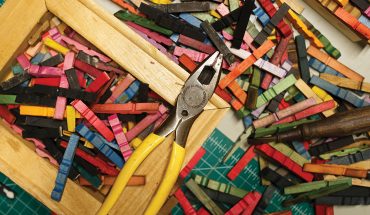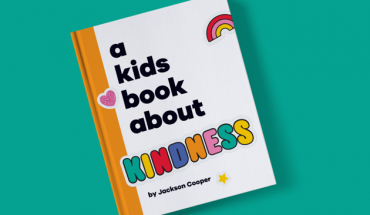Painter Jean Gray Mohs channels her life into her art in unexpected and evolving ways.
by Susanna Klingenberg | photography by Taylor McDonald
A master raconteur, local artist Jean Gray Mohs can weave a narrative, inspire emotion and connect with her audience, all through paint, charcoal and pen.
But Mohs’ own story—the primary fodder for her body of work—was very nearly cut short by interstitial lung disease, an increasingly debilitating illness that slowly robbed her of the breath that fueled her body, her family and her art.
To study Mohs’ body of work is to dive into a thoughtful exploration of life, hers and yours. Her work is at once intensely personal and universal, exploring topics like childbearing, health, joy, grief and family. That mine-is-yours approach is inherent to Mohs’ warm personality, but it’s also by design. “I want my work to establish dialogue with people,” she explains. “I want to facilitate a meaningful experience, for people to have something to take away.”
Over the years, Mohs’ mediums have ranged from forest moss to charcoal to acrylics. She approaches art through the lens of a storyteller: the idea comes first and the presentation follows suit. Since her art explores her life, a subject that’s inherently dynamic, her style is always unfolding. Mohs is pragmatic about the diversity of her work: she says each new chapter naturally demands a new approach simply because, “I haven’t lived just one story.”
Museum consultant Emily Kotecki explains it this way: “As [Mohs’] life evolves, her aesthetic evolves. Her materials, style and even the size of her canvas change. Some artists explore an approach or technique for a long time. Jean Gray responds to her life through her art; maybe the best way to describe her aesthetic is ‘authentic.’”
That bent toward authenticity was part of Mohs’ story from the very beginning. Her mother jokes that Mohs was making art in the womb; at age five, she declared: “Mom, I am art!” Her formal education began with art lessons in the basement of a childhood neighbor. “Being a creator, a problem solver, a thinker, a facilitator—that’s always been my identity,” Mohs says. “I think even my five-year-old self knew that.”
Despite that intuition, she didn’t claim the title “artist” until much later. She describes her relationship with art in those early days as unrequited: “I felt like art had chosen me, but I hadn’t necessarily chosen art.”
After college, though, Mohs “chose art, and chose it all the way.” She moved to Georgia to join an artist group, Stillmoreroots. Together, they applied for a grant, were awarded funding, and opened Gallery RFD. She put in hours at the studio and in the classroom, receiving her masters degree in education and teaching elementary art.
Mohs admits that she has a “teacher soul,” but her educator colleagues say her success in the classroom is all about authenticity—just like her artwork. Melissa Oliver, who taught with Mohs at Creech Road Elementary, explains, “It was simply the relationships she built with her students and the genuine encouragement students felt in her classroom.”
As her dual career as teacher and artist was taking off, Mohs’ body was growing increasingly weak due to her lung disease. She had been officially diagnosed at age 19, and with each passing year, breath was harder to come by. Despite her physical limitations, Mohs’ remained indomitable in spirit. She met her husband, got married, and had twins through a surrogate, who Mohs describes as “an unbelievably selfless friend who offered up her body to grow our family.” Of course, anticipating her children’s birth and savoring new life gave her plenty of material, inspiring a series called Fruits of Our Labor.
By the time her twins were four, Mohs was dependent on oxygen. A season of celebrating new life turned to a season of reckoning with the end of her own.
Over the course of a year and a half—short on breath and increasingly short on time—Mohs created the abstract acrylic series 12-20: An Adult at Rest. Its origin: A sedentary adult will take anywhere from 12-20 breaths per minute, and the paintings—some oversize, some tiny—each captured a snapshot of what she imagined to be involved in one of those breaths. The series contains layering, overlapping, interacting pieces that feel dragged through areas of resistance, mirroring Mohs’ increasingly anxiety-filled breath.
At first glance, the pieces in 12-20: Adult at Rest don’t look like a meditation on mortality; they look like a study in color. But a closer look reveals a sort of trusting surrender within the art: Mohs forefronted her process as a way of processing her own life and death.
Mohs confirms, “I wanted all the marks to be seen. I wanted the mess to be there.” In the larger pieces, she allowed paint to drip, let unintentional marks remain. The smaller pieces were stark, with minimal marks and no erasing. “It was a reminder that we are not in control,” says Mohs. “It was a way for me to find beauty in the unknown.”
When Mohs debuted 12-20: An Adult at Rest at the Sertoma Arts Center last May, she was near the end of her life.
Then, suddenly, the story flipped: a week after her show, Mohs was admitted to the Duke transplant program and began physical therapy to prepare her body for a double lung transplant.
After less than a month of physical therapy, she got the call: a pair of lungs from an anonymous donor awaited her at Duke. She was overjoyed, of course. But she also knew firsthand the grief her donor’s family was experiencing. At 17, she had lost her younger brother, who was also an organ donor. Mohs said a prayer for her donor and their family, headed to Duke and, just an hour after the call, was being prepped for transplant surgery.
It went smoothly, though with the expected hardships of such a major procedure. And just like that, Mohs—who had so recently reckoned with the end of her story—woke up to the prospect of telling a new one.
But after such a life-altering event, where does a storyteller even begin?
At first, says Mohs, “there was insane elation. I was like a brand-new baby; everything I did felt like it was the first time.” Everything, she realized, also included her art.
“After surgery, I tried to make work in the style I was working in before. And it felt so unnatural and forced. So I’ve taken a step back. Now is the forming period. I’m allowing the sediment to settle, so I can see what needs to come next.”
Her patience is paying off. Lately she’s felt a “gathering,” pieces coming together toward the next phase of her work.
Fans know it’s worth the wait. Local designer Rebecca Necessary says she’s excited to see how this perennially-fresh artist translates a new chapter onto the canvas. Necessary has collected Mohs’ work for years and relishes how easily the paintings have become a part of her family’s story: “Mohs has this ability to leave just enough open for all of us to find our own meaning and connection, while still feeling connected to her.”
That is Mohs’ gift: to tell her own story, extraordinary as it is, in such a way that we can see ourselves reflected in it. As Mohs steps into this new chapter—bodily, emotionally, artistically—she’ll be accompanied by all those who have connected with her work before, and a growing base who can’t wait to see what story she’ll
tell next.







